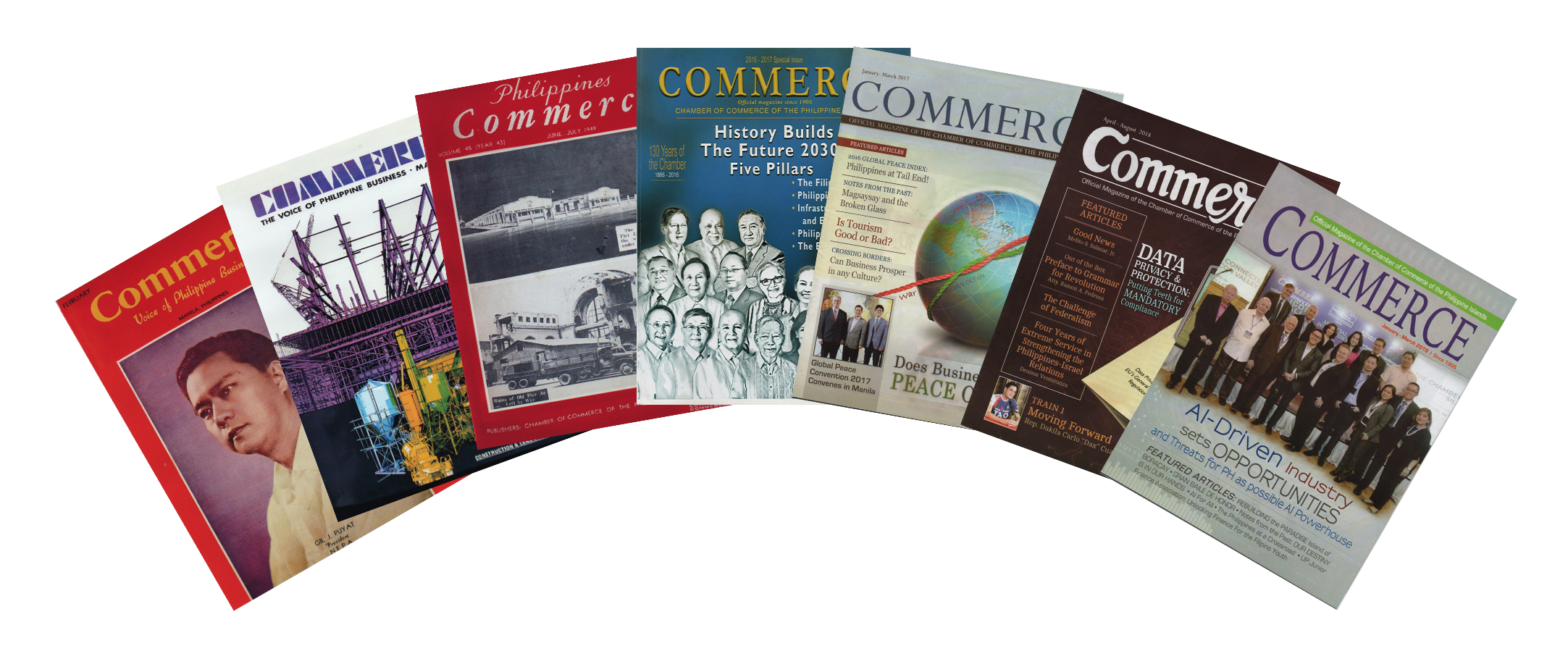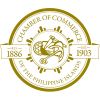Commerce Magazine

HISTORY OF COMMERCE MAGAZINE
Before the Chamber of Commerce of the Philippines was founded in 1903 by a handful of patriotic and ambitious Filipino businessmen, little had been thought of the need of organizing a trade organization that could voice their interests and serve as a rallying point for unity and strength. This latent interest for collective representation in matters affecting the social and political rights of the Filipino during the early days of the American regime, may be attributed to the more than three centuries of oppressive Spanish rule, notwithstanding those progressive and radical principles bequeathed to us by our martyr-heroes.
With the introduction however of democratic principles by the Americans, especially by freedom of speech and the press, the Filipinos began to realize the importance of collective action. The change of sovereignty changed the complexion of business. During the long Spanish regime little importance, if at all, was given to business. It was not considered as a profession, but rather as a menial occupation. A marked leaning towards the liberal professions was observed and nothing was done to deviate this preference, which had eventually causes the irritating position of insignificant minority in the business of our country, which was inherited from our sires. It was surely an herculean task that confronted the pioneers among our businessmen who organized the Chamber. The energy and the material support expended to overcome the almost insurmountable difficulties that they encountered were later compensated, for, as proved later, Chamber’s activities paved the way for better business and commerce with the outside world. Vicente Madrigal, Juan B. Alegre, Jose V. Ramirez, Alfonso M. Tiaoqui, Vicente P. Genato, Manuel E. Cuyugan, Vicente T. Fernandez and many others proved themselves leaders in espousing better business relations.
Because of the manifold problems that confronted them in the conduct of business, these pioneers who were nurturing the chamber with their enthusiasm and financial support, found it difficult to meet the challenge, that of working for the material progress of the country without a physical organ that could make vocal their aspirations and air their common problems to the powers-that-be. Hence, the coming into being of our official publication.
It should be recorded that the Chamber of Commerce of the Philippines was organized as “Camara de Comercio de Filipinas” and it is perhaps due to this original name that the CCP is still referred to at present as Philippine Chamber of Commerce. Our organ was not identified as “COMMERCE”, but simply as the “Revista de la Camara de Comercio Filipinas”, and later as “Revista de la Camara de Comercio de las Islas Filipinas”, the incorporated name of the Chamber since 1916.
It was originally published in Spanish Assertive editorials were printed reflecting the views of the Chamber on specific issues, which were hammered on until the point was won or definite defeat faced. From the start up to 1927, when the publication was taken over financially by former President Leopoldo R. Aguinaldo, then a director of the Chamber, it was edited and managed by the Secretary of the Chamber. Mr. Aguinaldo engaged an editor and financed its publication. It was he who adopted the name “COMMERCE” which had two sections, English and Spanish. Later, only English was used, as at present. The change in name was made to identify it as the official organ of the Chamber. A few years later, Mr. Aguinaldo turned over the publication to the Chamber, after losing around fifteen thousand pesos.
Publication was again assumed by the Chamber, with the Secretary as Editor, in 1936. Decidedly, the Aguinaldo investment enhanced and improved the quality of the publication and the organization set up by him was continued, with a staff appointed by the Board, which consisted of the Secretary as editor, a business manager, an associate editor and circulation manager.
It was then when COMMERCE appeared in de-luxe garb, printed on heavy paper, the format which made it the most expensive, authoritative and exclusive trade publication in the Philippines. War in the Pacific cam and halted the publication. The last pre-war issue of COMMERCE was for November 1941 and during the occupation years “went underground” so to say, as its publication was discontinued, not suspended by the enemy, on our own volition. In January 1946, one year after liberation, the first post-liberation issue was printed and continued ever since. About one year before the last war, the Secretary discontinued his editorship of the
magazine and this arrangement has been observed up to the present time.
Benjamin V. Salvosa succeeded Pedro J. Ocampo, who was then Secretary of the Chamber, as editor from January to April 1946, when Pio Pedrosa took over the management. Pedrosa was assisted by Vicente J. Guzman. In November 1946, due to the appointment of Pedrosa as Commissioner of Budget, he relinquished his position to Eliseo Quirino, who served as managing editor up to December 1951 when he was elected provincial executive the following year. During the term of Quirino, he was assisted by Fernando Leaño, Amado B. Isip and Domingo C. Abadilla. On January 1952, Dr. Jose R. Katigbak, chairman of the committee on ways and means, was appointed by the board of directors to hold the responsibility of the management of the magazine, assisted by M.M. de los Reyes as acting business manager.
In February 1952, the board of Directors of the Chamber again revamped the management by appointing a board of editors to the shoulder the responsibility composed of Dr. Jose R. Katigbak as chairman, and Domingo. C Abadilla and Hilarion P. Vibal as members. In July 5, 1952 the newly elected board of directors of the Chamber that year adopted Resolution No. 8 creating a Board of Editors with Director Teofilo D. Reyes as chairman, and Domingo C. Abadilla and Hilarion P. Vibal as members to run the management of the magazine. As a governing body, the Board is charged with the responsibility of managing, editing and supervising the magazine. The business aspect of the publication is taken cared of by the chairman with the assistance of Benito F. Medina as business manager and Carlos de Lara advertising manager. The layout of the magazine is prepared by Ricardo C. Biglang-Awa, staff artist, while the editors are assisted by staff member George A. Yulo.
Editors Note: Above article was lifted from the 1953 edition of COMMERCE Magazine during the magazines 48 th Anniversary.
Those were the early years in the history of COMMERCE. For decades, the COMMERCE has a lot of stories to tell. The development, struggle and survival of its internal publication and the tumultuous era of Philippine business after WWII. It has been the “Voice of the Philippine Business,” until it’s publication was discontinued during the Martial Law years.
After several decades, the 56 th President of the Chamber, Jose Luis U. Yulo, Jr., and its Executive Director, Denissa G. Venturanza, decided to revive the publication of the magazine as part of the Chamber’s rekindling and repositioning.
Through the support and contribution of the “friends” of the Chamber, the magazine has been published and circulated starting first quarter of 2015 and is being issued on a quarterly basis.
It is now being used as a tool in reflecting the vision of the Chamber of Commerce of the Philippine Islands under its slogan “History Builds the Future 2030: Five Pillars”.







